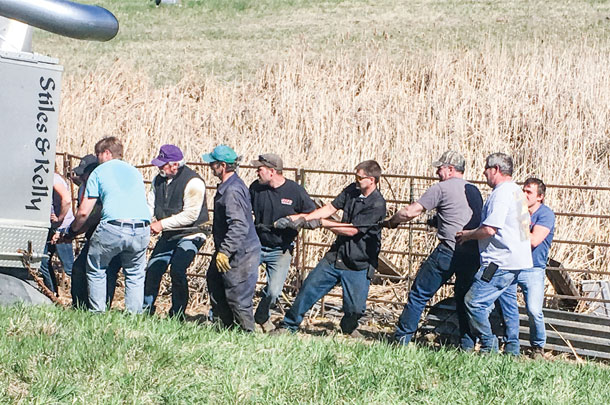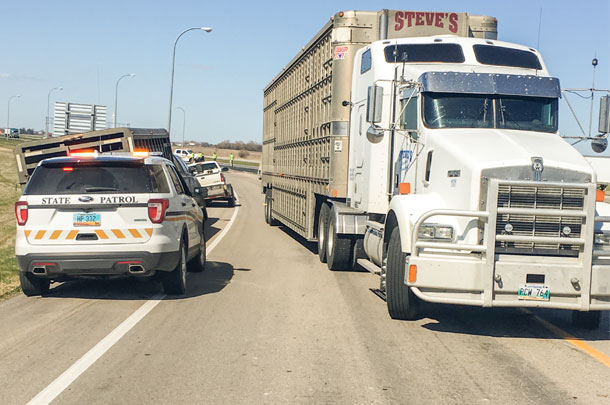As the threat preparedness and response officer for the West Virginia Department of Agriculture’s (WVDA) Homeland Security Unit, McCallister routinely aids in agriculture-related emergencies. Although not a first responder himself, he was called that day to provide resources to the team of emergency personnel who had never dealt with livestock motor vehicle emergencies.
Having recently participated in the national BERP course, McCallister was prepared to manage the situation.
“The very first thing I did was go up and down the road telling everyone to turn off their flashing lights,” McCallister says. “It’s not natural for first responders to turn off their lights, but it’s this type of thing you learn to do in the (BERP) class because of how cattle respond.”
After more than 13 hours on a blocked four-lane interstate highway, McCallister and the local response team were able to identify the appropriate resources and personnel to assist in cleaning up the incident.
Although nearly 40 head of cattle had to be humanely euthanized, no human injuries were reported, and the team was able to safely manage and euthanize cattle, while being mindful of biosecurity and mortality disposal issues. McCallister credits his training through the BERP program for providing him the knowledge and technical skills to assist.
“Going through this class causes you to go through this process of identifying resources, how you contact those resources and if you need contracts with any of them,” he says. “For me, it was a mental checklist. Having instructions, insight and resources to allow a jurisdiction to know what to do is absolutely essential.”
What started the program?
Each year, more than 50 million head of cattle are transported throughout the U.S. via truck and trailer, and 400,000 head of livestock are on the roads each day. Yet, prior to 2014, no standard operating procedures were available in the U.S. to address livestock-related traffic incidents.
One particularly jarring incident in North Dakota triggered a group of university extension specialists to design the nationally focused, educational BERP platform to assist first responders in addressing cattle-related motor vehicle incidents.

With funding from the Beef Checkoff and a United States Department of Agriculture (USDA) – National Institute of Food and Agriculture (NIFA) grant, the nation’s first BERP program rolled out in early 2014, offering continuing education to emergency personnel on appropriate response to motor vehicle emergencies involving food animals.
“The BERP program was born out of the Beef Quality Assurance (BQA) program,” Dave Workman, extension agent and extension associate professor at West Virginia University, says. “We targeted our educational program to first responders and to educators about what they could do to enhance response, safety and public perception.”
The BERP program focuses much of its training on BQA guidelines and adapts those guidelines for use in motor vehicle emergencies. Topics in the six-hour, hands-on training navigate each step of the emergency response progression in the form of a dispatch decision tree.
The 10-section plan begins when a call comes into dispatch and concludes with a final debrief. Included in the training are scene arrival procedures, triage considerations, extrication of livestock, righting of the crashed vehicle, as well as safe cattle handling, humane euthanasia and proper procedures for disposal of mortalities.
“One of the things that we knew wasn’t occurring within these incidents was that cattle weren’t being euthanized in a humane fashion, and maybe they weren’t always handled correctly,” Lisa Pederson, extension beef quality assurance specialist at North Dakota State University, says. “Animal handling and humane euthanasia are major components.”
Deputy Mike Westerbur with the Rock County Minnesota Sherriff’s Department in Luverne, Minnesota, attended a BERP session in October 2016 to earn continuing education credits. For him, the hands-on cattle handling and euthanasia demonstrations were the most impactful.
“Unfortunately, we have to put animals down quite often,” Deputy Westerbur says. “We live in a rural area, so we end up dealing with cattle and hogs. Knowing how to euthanize is expected of us, but we’re not formally trained. I’m not from a farm, so it was nice to learn the humane way.”
The BERP training has initiated livestock response planning for the Rock County Sheriff’s Department. Meetings have been coordinated with a local veterinarian, area cattlemen and the local fire department to identify specific needs in case of an accident. Peter Bakkan, a cow-calf and feedlot operator from Rock County, Minnesota, was part of that group.
“I’ve been on both sides,” he says. “I’ve been a farmer with 200 calves running on the road, and the officer was treating it as if a deer was hit.”
Bakkan says the program provides tools to avoid the chaos that often ensues during large-scale livestock accidents. To help pacify tense situations, the BERP framework guides first responders through the process of developing an emergency contact list that contains industry experts like veterinarians and area cattle producers.
“A farmer, cattle feeder or cow-calf rancher usually doesn’t think of himself as an expert, but there is a lot of expertise there that can be tapped,” Bakkan says.
Building a team
The BERP program suggests including the names and contact information of not only local farmers and ranchers who can provide expertise on cattle handling, but also of area veterinarians, brand inspectors, livestock disposal facilities, sale barns or other venues that will take cattle after an accident, and even a tow truck. An effective emergency contact list should include multiple contacts in each category.
“As we always say, ‘The scene is not the place to build your team,’” Pederson says. “Develop that list several layers deep, so if the first person on the call list isn’t available, there’s somebody else who has been trained.”

The components of the BERP program are what prepared Roy McCallister to deal with the rolled cattle pot.
“The good part is that it doesn’t happen regularly,” McCallister says. “But that’s where this program comes in. It gives you the template to identify those resources … and gives you the confidence level to perform the duties you just learned about.”
Of the jurisdictions that have had the opportunity to put BERP into action, the majority have reported the training to be valuable during a response. Many jurisdictions, like the Rock County Sheriff’s Department, have made changes to their local response plans based on knowledge gained during the BERP seminar.
For Workman, Pederson and members of the BERP team, garnering feedback from first responders on the program’s value is gratifying.
“When a sheriff responds in an after-action report that this type of training should be offered to all first-year deputies within the first three weeks on the job, then you realize that this is pretty important stuff,” Workman says. “It’s a testament to the value of the program.”
BERP program trainers are available across the country to provide programming and are currently exploring alternative methods to deliver content. For more information on scheduling a BERP training, contact your state BQA coordinator or state beef extension specialist. ![]()
PHOTO 1: High winds resulted in the tipping of the pictured truck and trailer as it took an offramp near the North Dakota and Canadian border.
PHOTO 2: Unable to access the majority of the cattle from the back doors, the roof was cut away to allow incident responders to remove the remaining cattle.
PHOTO 3: The cattle that were able to walk were held until additional trailers could arrive for transport. Photos provided by Samantha Lahman.
Steven Boyles, Ph.D., Ohio State University; Darin Matlick, DVM, West Virginia University; Lisa Pederson, North Dakota State University; Jan Shearer, DVM, Iowa State University; Dave Workman, West Virginia University; and Jerry Yates, West Virginia University are all BERP collaborators.

-
Libby Bigler
- Colorado BQA Coordinator
- Colorado State University
- Email Libby Bigler








